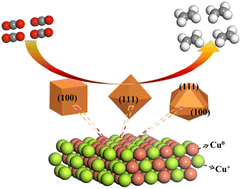In situ surface/interface generation on Cu2O nanostructures toward enhanced electrocatalytic CO2 reduction to ethylene using operando spectroscopy†
Abstract
Electrocatalytic CO2 reduction reactions (CO2RRs), an efficient method of converting carbon dioxide into valuable fuels and chemicals, are attractive as well as challenging. In this work, Cu2O nanostructures with active facets (face-raised cubic structures (F-Cu2O) with the (100) facet, octahedral structures (O-Cu2O) with the (111) facet and edge- and corner-truncated octahedral structures (T-Cu2O) with both the (100) and (111) facets) were synthesized by a wet chemical reduction method. The surface of Cu2O nanostructures was reconstructed in situ to form Cu2O/Cu with a highly active interface during the conversion of CO2 into C2H4, which is named F-Cu2O/Cu, O-Cu2O/Cu and T-Cu2O/Cu. The C2H4 selectivity on Cu2O/Cu catalysts follows the order of O-Cu2O/Cu < F-Cu2O/Cu < T-Cu2O/Cu, and the faradaic efficiencies of C2H4 are 11.2%, 24.9%, and 58.0% at −1.1 V versus the reversible hydrogen electrode, respectively. The experimental results combined with operando surface-enhanced Raman spectroscopy reveal that the Cu2O/Cu interface enhances *CO adsorption and decreases the activation energy of C–C coupling, which is also supported by density functional theory (DFT) calculations. This study will pave a feasible pathway for electrochemical energy storage and convention by crystal facet engineering and interface engineering.

- This article is part of the themed collection: FOCUS: Recent progress on electrocatalytic CO2 reduction


 Please wait while we load your content...
Please wait while we load your content...